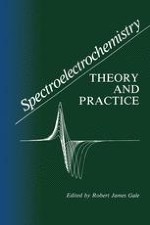1988 | OriginalPaper | Chapter
ESR Spectroscopy of Electrode Processes
Authors : Richard G. Compton, Andrew M. Waller
Published in: Spectroelectrochemistry
Publisher: Springer US
Included in: Professional Book Archive
Activate our intelligent search to find suitable subject content or patents.
Select sections of text to find matching patents with Artificial Intelligence. powered by
Select sections of text to find additional relevant content using AI-assisted search. powered by
Electron spin resonance (ESR) is an attractive technique for the identification and study of species containing an odd number of electrons (radicals, radical cations and anions, and certain transition metal species). The experiment is based on the fact that whereas in the absence of a magnetic field, the two possible spin states, $$ + \frac{1} {2},\, - \frac{1} {2} $$, of an unpaired electron have identical energies, this degeneracy is lost when a field is applied. ESR spectroscopy involves the flipping of the spin between the two now different energy levels, an act which is brought about by the absorption of microwave radiation. As will be shown below, the presence of magnetic nuclei in the molecule is revealed as hyperfine structure in the ESR transition, which thus may be used to provide a positive identification of the odd-electron species. Since each magnetic nucleus contributes (at least in principle) to the hyperfine structure, a rather more intimate insight into molecular identity emerges than from, for example, UV-visible spectroscopy. It is this high information content of ESR spectroscopy, together with the sensitivity of the technique (radical concentrations on the order of 10−8M may be observed with standard equipment(1)), that has made ESR the method of choice for investigating complex electrode reactions which proceed via radical intermediates. Other advantages are that the specificity towards paramagnetic species is advantageous in some cases, that the technique is nonperturbing (there is no activation or destruction of the sample), and that absolute concentrations may be measured (albeit with limited accuracy).
